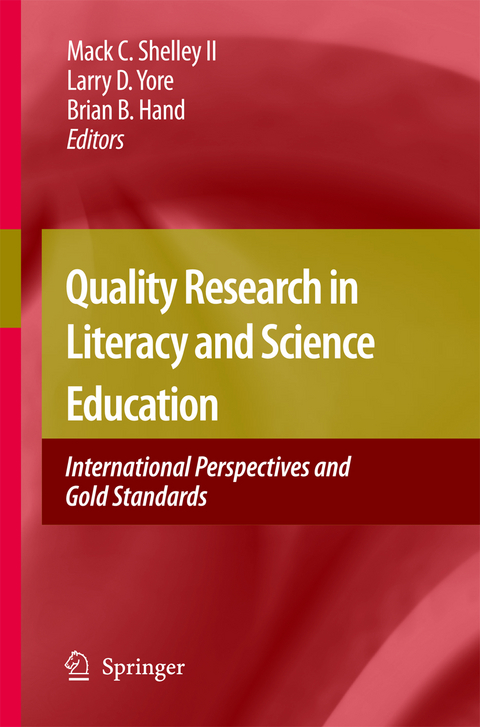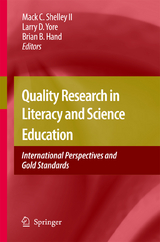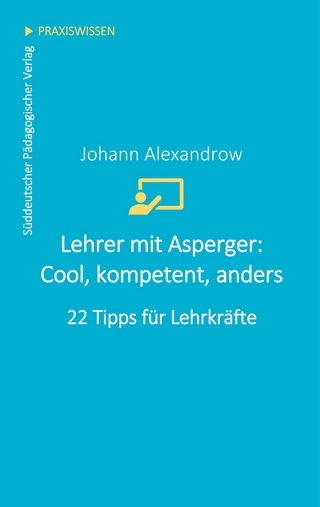Quality Research in Literacy and Science Education
Springer-Verlag New York Inc.
978-1-4020-8426-3 (ISBN)
General Introduction.- Education Research Meets the “Gold Standard”: Evaluation, Research Methods, and Statistics after No Child Left Behind.- Setting the Agenda: Science Education and Science-based Research.- Why “Gold Standard” Needs Another “s”: Results from the Gold Standard(s) in Science and Literacy Education Research Conference.- Research and Practice: A Complex Relationship?.- Moving Beyond the Gold Standard: Epistemological and Ontological Considerations of Research in Science Literacy.- Longitudinal Studies into Science Learning: Methodological Issues.- An International Perspective of Monitoring Educational Research Quality: Commonalities and Differences.- Considering Research Quality and Applicability Through the Eyes of Stakeholders.- Curriculum and Pedagogy.- Researching Effective Pedagogies for Developing the Literacies of Science: Some Theoretical and Practical Considerations.- Pedagogy, Implementation, and Professional Development for Teaching Science Literacy: How Students and Teachers Know and Learn.- Approaching Classroom Realities: The Use of Mixed Methods and Structural Equation Modeling in Science Education Research.- Mixed-methodology Research in Science Education: Opportunities and Challenges in Exploring and Enhancing Thinking Dispositions.- New Directions in Science Literacy Education.- Statistics, Research Methods, and Science Literacy.- Multilevel Modeling with HLM: Taking a Second Look at PISA.- Methods from Item Response Theory: Going Beyond Traditional Validity and Reliability in Standardizing Assessments.- Confounding in Observational Studies using Standardized Test Data: Careful Disentanglement of Statistical Interpretations and Explanations.- Predicting Group Membership using National Assessment of Educational Progress(NAEP) Mathematics Data.- Incorporating Exploratory Methods using Dynamic Graphics into Multivariate Statistics Classes: Curriculum Development.- Approaches to Broadening the Statistics Curricula.- Dr. Fox Rocks: Using Data-mining Techniques to Examine Student Ratings of Instruction.- Process Execution of Writing and Reading: Considering Text Quality, Learner and Task Characteristics.- Can We Make a Silk Purse from a Sow's Ear?.- Public Policy and “Gold Standard(s)” Research.- Speaking Truth to Power with Powerful Results: Impacting Public Awareness and Public Policy.- Funding Patterns and Priorities: An International Perspective.- Research Ethics Boards and the Gold Standard(s) in Literacy and Science Education Research.- Data Sharing: Disclosure, Confidentiality, and Security.- Stitching the Pieces Together to Reveal the Generalized Patterns: Systematic Research Reviews, Secondary Reanalyses, Case-to-case Comparisons, and Metasyntheses of Qualitative Research Studies.- The Gold Standard and Knowing What to Do.- Epilogue: New Standards, New Directions, and New Realities.- Reflections on Beyond the Gold Standards Era and Ways of Promoting Compelling Arguments about Science Literacy for All.
| Zusatzinfo | XXIX, 666 p. |
|---|---|
| Verlagsort | New York, NY |
| Sprache | englisch |
| Maße | 155 x 235 mm |
| Themenwelt | Sozialwissenschaften ► Pädagogik ► Bildungstheorie |
| ISBN-10 | 1-4020-8426-9 / 1402084269 |
| ISBN-13 | 978-1-4020-8426-3 / 9781402084263 |
| Zustand | Neuware |
| Haben Sie eine Frage zum Produkt? |
aus dem Bereich




